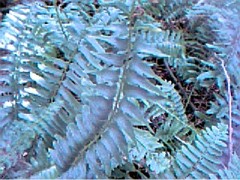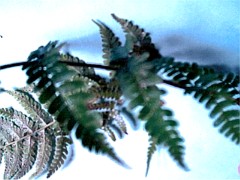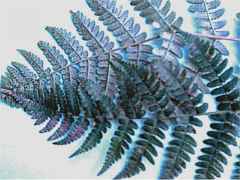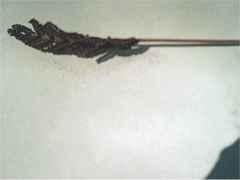Find Ferns,> fern plant care, establish native plants. Mixing perennials with your fern and shade plants.
The majority of
these evergreen and perennial fern species are Part Of the
Cool-Greenery Collection (Nutramedical's).
Ferns have a wide geographical distribution, their 10,000 different
species and varieties being found almost throughout the whole world. From those
growing sparsely in the arctic to varieties burgeoning in the tropics, these
flower less plants prefer island and coastal areas to those inland.
Hardy, Evergreen, Indigenous Ferns
Most of these
ferns are relatively easy to grow in protected, shaded areas. Many of them grow
in rocks and walls. Most are not as big as the perennial ferns of Maryland,
don't need as much water, and prefer acidic soil and/or
limestone.
Most of the Ferns below, and many more are avialable in
varying sizes... Three year olds to Landscape size Ferns...

 |
|

| 7. Evergreen
Christmas Fern
This is an upright growing wall fern with willow like leaves. Younger ferns of this species look similar to the Maidenhair. Grows to a foot, in poor soil and often in old brick or rock structures.    |
 See
more?? See
more?? |
9. Polypody
Fern This is a spreading hardy fern that lives mostly on rocks. (common polypody) Forms low, spreading mats of foliage and occurs in many interesting and beautiful varieties. Rarely grows more than 12 inches high. A few members of this extensive family are well adapted to greenhouse cultivation, chiefly Polyplodium aureum and its varieties. Polyplodium aureum (hare's-foot fern), from Australia, has creeping stems clothed with bright rusty scales, and handsome lobed foliage which may easily exceed 2 feet in length. The plant itself may spread to 10 feet across. |
|
| |
Indigenous Perennial Ferns The 1st ones listed here are native to Central and Eastern U.S. and some of them are the largest ones around. All of these ferns lose their leaves for the winter months. The 2 largest specimens are the Cinnamon Fern (4'-6") and the Ostrich Fern (5'-9"). | |
 |
10. Ostrich
Fern (Matteuccia struthiopteri)(Pteretis nodulosa)
This is a nice propagating fern. It can reach 6 ft. Large ostrich-like leaves. Open shade preferred; however, can tolerate sun in swampy areas. Likes to be near water. Spreads rapidly. Deciduous. 3-7 feet. Frond have been know to reach 9 ft. long!.. Growing quickly in moist soil. Hardiness: Zones 3-6. |
 |
11. Marginal
Woodfern, (Evergreen Wood Fern, Leatherleaf or Marginal Sheld Fern)
(Dryopteris marginalis) Leathery evergreen, and hardy in any semi-shaded pockets of light rich soil, either acid, alkaline, or neutral. Gaining a height of a few inches to three feet, the graceful blue-green fronds of the Evergreen Wood Fern rises above the snow and flourishes throught the winter.  For
shipping purposes the fronds have been necessarilly trimmed back, but this
years fiddle heads are already coming out! For
shipping purposes the fronds have been necessarilly trimmed back, but this
years fiddle heads are already coming out!
|
 |
12. Cinnamon
Fern Looks like a larger Interrupted Fern. Called Cinnamon Fern because of the erect rusty brown fronds that appear in the spring. Foliage begins as a pale green that darkens during summer, eventually turning a rich brown by autumn. Deciduous. Indifferent to light if soil moisture is maintained. Grows to 5 ft. Hardiness: Zones 3-10. A relative is the Interrupted, pictured above, and the Royal, pictured below. |
 |
13. Royal
Fern (Osmunda regalis) Prefers shade and moisture, and reaches 5'. The most conspicuous of all native hardy ferns, attains its majestic proportions. Easily cultivated in any moist place, such as the side of a lake or stream or pool. Its fronds a delicate pale green in spring, changing with the approach of autumn to light russet-brown are of two kinds: the fertile, approximately 3 ft. long, and the barren, which are more numerous, 5 ft. or more long. |
 | |
 |
15. Hay-Scented
Fern (Dennstaedtia punctilobula)
This is a propagating fern that is exudes a hay-like scent when damaged. Grows 24-36 inches high. A brittle yellowish-green fern, tending to become ragged in late summer. Likes it dry, and partially shaded. Spreads rapidly, and is difficult to control. |
 |
16. Broad Swamp
Fern or Clinton's Wood Fern (Dryopteris cristata
Clintoniana) This is a swamp fern that needs wet soil. This is a much larger and more showy plant than the Crested Sheild Fern, (of which the Clinton's Fern is a var. of). Firm-textured, bluish-green Woodfern of moist forests. In wet soil can tolerate sun. |

| |

| |

| 18. Goldie's
Fern or Giant Wood Fern (Dryopteris
goldiana) The giant of our Woodferns. Two foot to more than four foot. Its golden-green color, large coarse sized fronds of this stately plant unfurl themselves in the golden twilight of the deeper woods. Likes moist and rich soil, in a cool, shaded, well drained location. |
 |
19. Lady
Fern (Athyrium Filix-femina) A medium sized fern (1-3 foot) that lives in a wide range of moist conditions. A rather showy, vigorous, lacy-cut, fern-like fern. The earliest fronds uncurl in May. Is considered by many to be one of the loveliest of all ferns, is seen at its best when planted in colonies and interspersed with anemones and rosy cranesbills. Likes shade and rich soil. |
 |
21. Blunt-Lobed
Woodsia Fern (Woodsia obtusa) This is light green delicate, often evergreen fern that lives about rocky banks and cliffs, dry rocky woods in neutral moist but not acid soil (The Blunt-Lobed Woodsia is not rare on rocks). Growing 8-20 inches, and produces new leaves throughout the season. Is full green and more delicate and larger in shade; pale green, smaller and coarser when exposed to sunlight. |
 |
23. Sensitive
Fern or Bead Fern (Onoclea sensibilis)
Small ones look like the Net-Veined Chain Fern but lighter colored. These can be found one or two inches to three feet high. Sturdy, coarse, unfernlike fern, with broad almost triangular leaves, which tilt upward and backward. Like shade, but in damp or wet places will tolerate full sun. Dies quickly with first frost, leaving only the erect, bead-like, fertile spikes. 
The plant holds its own among the largest and most effective ferns. The fronds wear a very light and delicate shade of green. There is nothing, however, specially fragile in the plant's appearance, and one is struck by the inappropriateness of its title. Which probably arose from its sensitiveness to early frosts. |
| Last updated: 10/01/2000 | |
Nutramedical's Herb Index: Many Of The Herbs Listed There are Wild Crafted!